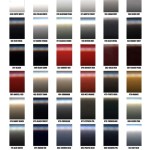How To Choose A Paint Color Scheme For Your Home
Selecting a paint color scheme for a residence is a multifaceted undertaking that significantly influences the aesthetic appeal, perceived space, and overall atmosphere of the interior and exterior environments. A well-chosen color scheme can enhance architectural features, create a sense of harmony, and reflect the occupants' personal style. Conversely, a poorly executed color selection can result in a visually jarring or uninviting space. Therefore, a systematic approach, considering various factors, is crucial to achieving a satisfactory and enduring outcome.
The process of choosing a paint color scheme should extend beyond simply selecting preferred colors. It necessitates a thorough assessment of the existing environment, an understanding of color theory, and a consideration of the intended purpose of each space. Furthermore, practical considerations such as lighting conditions, architectural style, and the presence of existing furnishings and décor must be factored into the decision-making process.
Understanding the Fundamentals of Color Theory
Color theory provides a foundational understanding of how colors interact and influence perception. A fundamental element of color theory is the color wheel, which illustrates the relationships between primary, secondary, and tertiary colors. Primary colors, namely red, yellow, and blue, are the base from which all other colors are derived. Secondary colors, such as green, orange, and violet, are created by combining two primary colors. Tertiary colors result from mixing a primary color with an adjacent secondary color.
Understanding color harmonies is also critical. Complementary colors, located opposite each other on the color wheel (e.g., red and green), create a vibrant and contrasting effect. Analogous colors, situated next to each other on the color wheel (e.g., blue, blue-green, and green), produce a harmonious and cohesive scheme. Triadic colors, comprising three colors equally spaced on the color wheel (e.g., red, yellow, and blue), offer a balanced and dynamic palette. Monochromatic schemes involve using variations of a single color, ranging from light tints to dark shades, to create a subtle and sophisticated effect.
The psychological impact of colors should also be considered. Different colors evoke different emotions and associations. For example, blue is often associated with calmness and serenity, making it a suitable choice for bedrooms or bathrooms. Red is often linked to energy and excitement, making it appropriate for accent walls or spaces where a stimulating atmosphere is desired. Green is associated with nature and tranquility, making it a versatile choice for various rooms. Yellow is associated with happiness and optimism, bringing warmth and brightness to interior spaces. Neutral colors, such as white, gray, and beige, provide a versatile backdrop that allows other colors to stand out and can create a sense of spaciousness and airiness. While these are common associations, individual responses to color can vary based on personal experiences and cultural background.
Assessing the Existing Environment and Architectural Style
Before delving into specific color choices, a comprehensive assessment of the existing environment is essential. This involves evaluating the architectural style of the residence, the amount of natural light available, and the existing furnishings and décor. The architectural style can dictate certain color palettes that are more appropriate or historically accurate. For example, a Victorian-era home might benefit from richer, more saturated colors, while a modern minimalist home might favor a more subdued and neutral palette.
The amount of natural light significantly impacts how colors are perceived. Rooms with abundant natural light can handle bolder, darker colors without feeling cramped or oppressive. Conversely, rooms with limited natural light benefit from lighter, brighter colors that reflect light and create a sense of spaciousness. Artificial lighting also plays a role; incandescent lighting tends to warm colors, while fluorescent lighting can cool them down. It is advisable to test paint samples under different lighting conditions before making a final decision.
Existing furnishings and décor should also inform the color scheme. Consider the colors of existing furniture, flooring, artwork, and other accessories. The paint color should complement these elements, creating a cohesive and harmonious look. It is often beneficial to choose a paint color that ties together the various elements in the room, creating a unified and balanced aesthetic.
Furthermore, the size and shape of the room must be taken into account. Lighter colors can make a small room appear larger, while darker colors can make a large room feel more intimate and cozy. Vertical stripes can make a ceiling appear higher, while horizontal stripes can make a narrow room seem wider. The strategic use of color can effectively alter the perceived dimensions of a space.
Developing and Testing the Color Scheme
Once the foundational understanding of color theory is established and the existing environment is assessed, the next step involves developing and testing the color scheme. This process typically involves selecting a primary color, secondary colors, and accent colors. The primary color serves as the dominant hue in the space, while secondary colors complement the primary color and provide visual interest. Accent colors are used sparingly to add pops of color and draw attention to specific architectural features or décor elements.
When selecting colors, it can be helpful to gather inspiration from various sources, such as magazines, websites, and nature. Creating a mood board can be a useful tool for visualizing the overall look and feel of the space. This involves collecting images, fabric swatches, and paint samples that represent the desired aesthetic.
It is essential to test paint samples in the actual space before making a final decision. Paint colors can look significantly different under different lighting conditions and against different backgrounds. Paint small squares of the chosen colors on different walls in the room and observe them at various times of the day and night. This will allow for a more accurate assessment of how the colors will appear in the space.
Consider the sheen of the paint as well. Different sheens reflect light differently and are suitable for different applications. Flat or matte sheens are ideal for ceilings and low-traffic areas as they hide imperfections. Eggshell or satin sheens are more durable and easier to clean, making them suitable for living rooms and bedrooms. Semi-gloss or gloss sheens are the most durable and easiest to clean, making them ideal for kitchens, bathrooms, and trim.
The exterior of a residence also warrants careful consideration when selecting a paint color scheme. The exterior color should complement the architectural style of the building and the surrounding landscape. It is often advisable to choose colors that are historically appropriate for the region. Consider the colors of neighboring homes to ensure that the chosen scheme integrates harmoniously with the overall neighborhood aesthetic.
Finally, documenting the chosen paint colors and sheens is a crucial step as well. Keeping a record of the paint names, brands, and sheens will facilitate future touch-ups or renovations. This information will also be helpful if additional paint is needed for other projects in the future.

Whole House Color Palette How To Choose A Paint Scheme

How To Pick A Color Palette For Your Home

How To Choose A Paint Color

Tips For Choosing Whole Home Paint Color Scheme House Schemes Palettes

9 Ways To Select The Perfect Home Colours For Your House

Whole House Color Palette How To Choose A Paint Scheme

Choose The Best Color Palette For Your Home Croc Painting

How To Create A Whole Home Color Scheme My Homier

Our Whole House Color Palette Young Love

15 Designer Tricks For Picking A Perfect Color Palette
Related Posts








